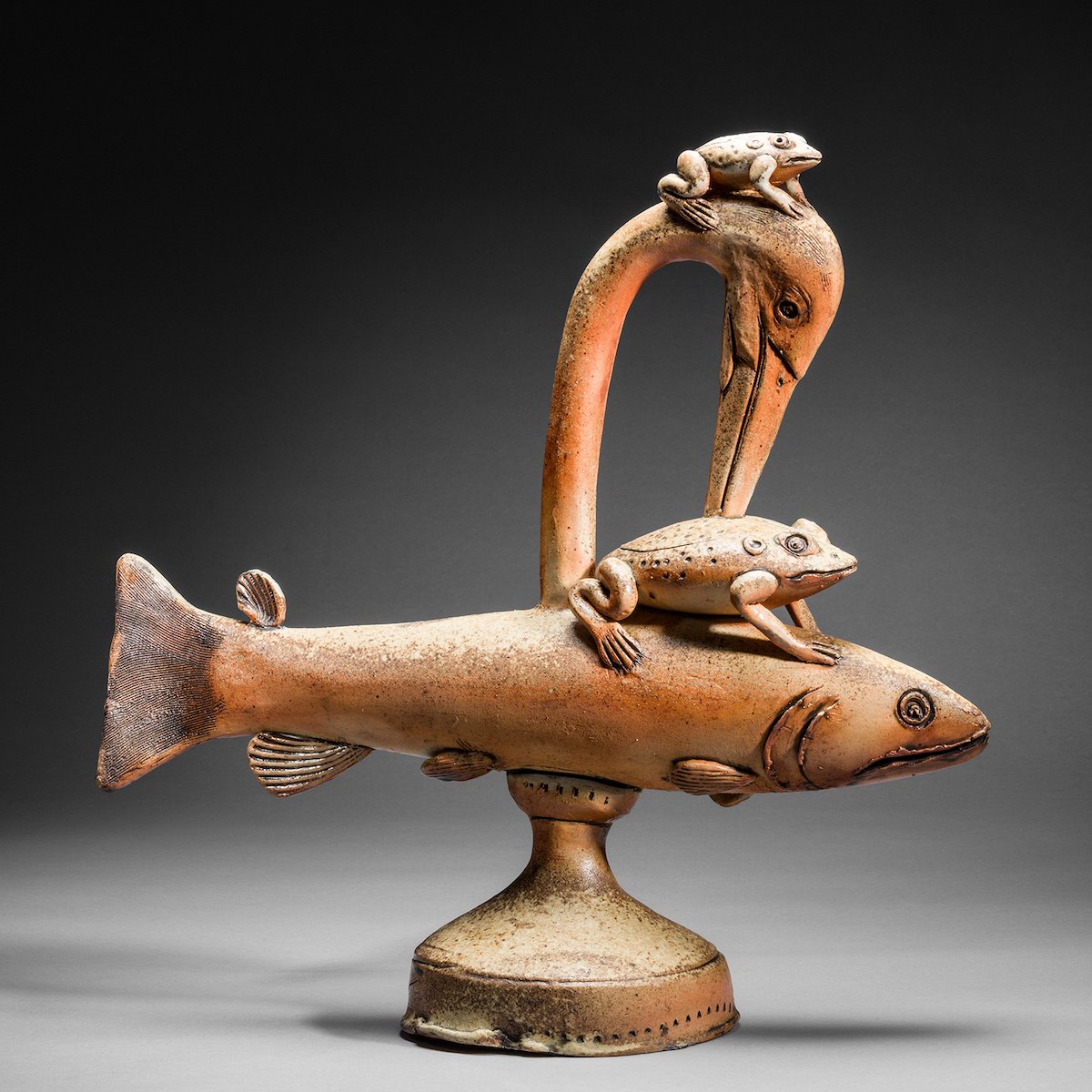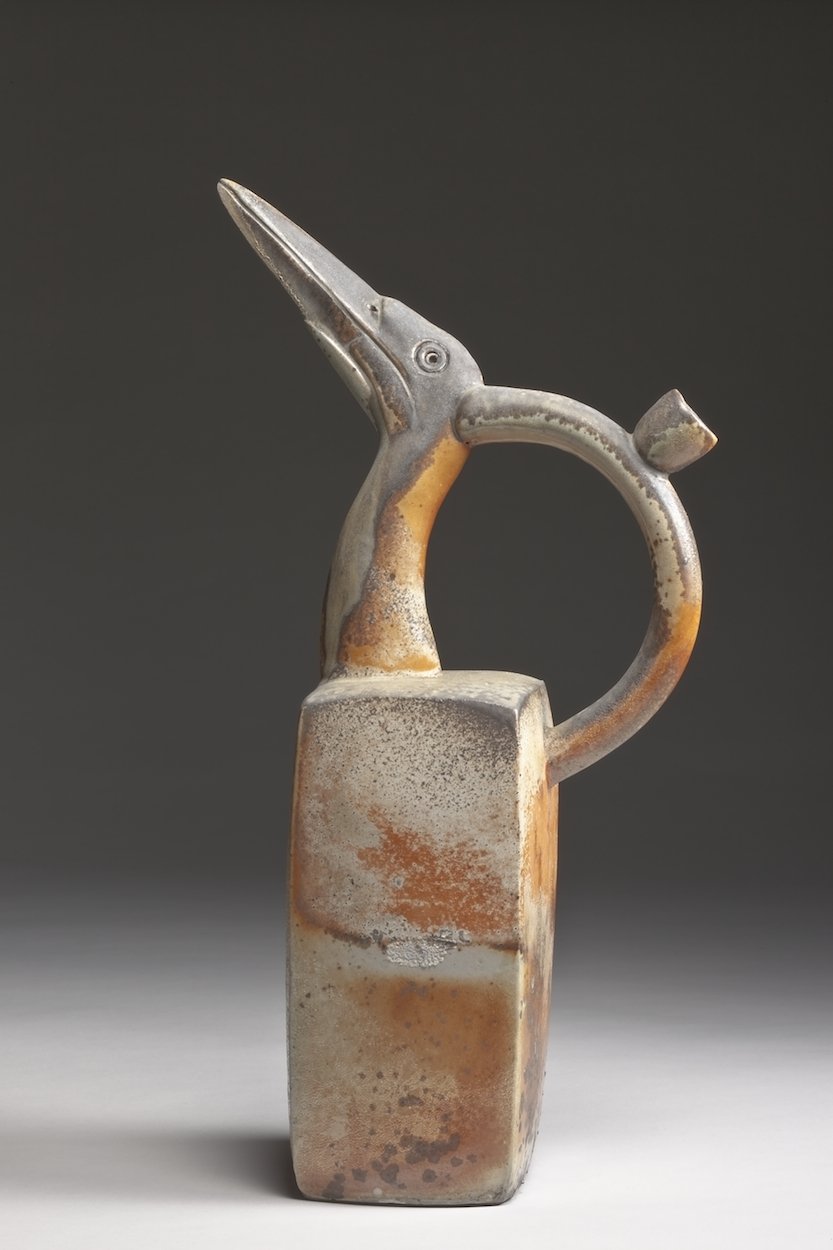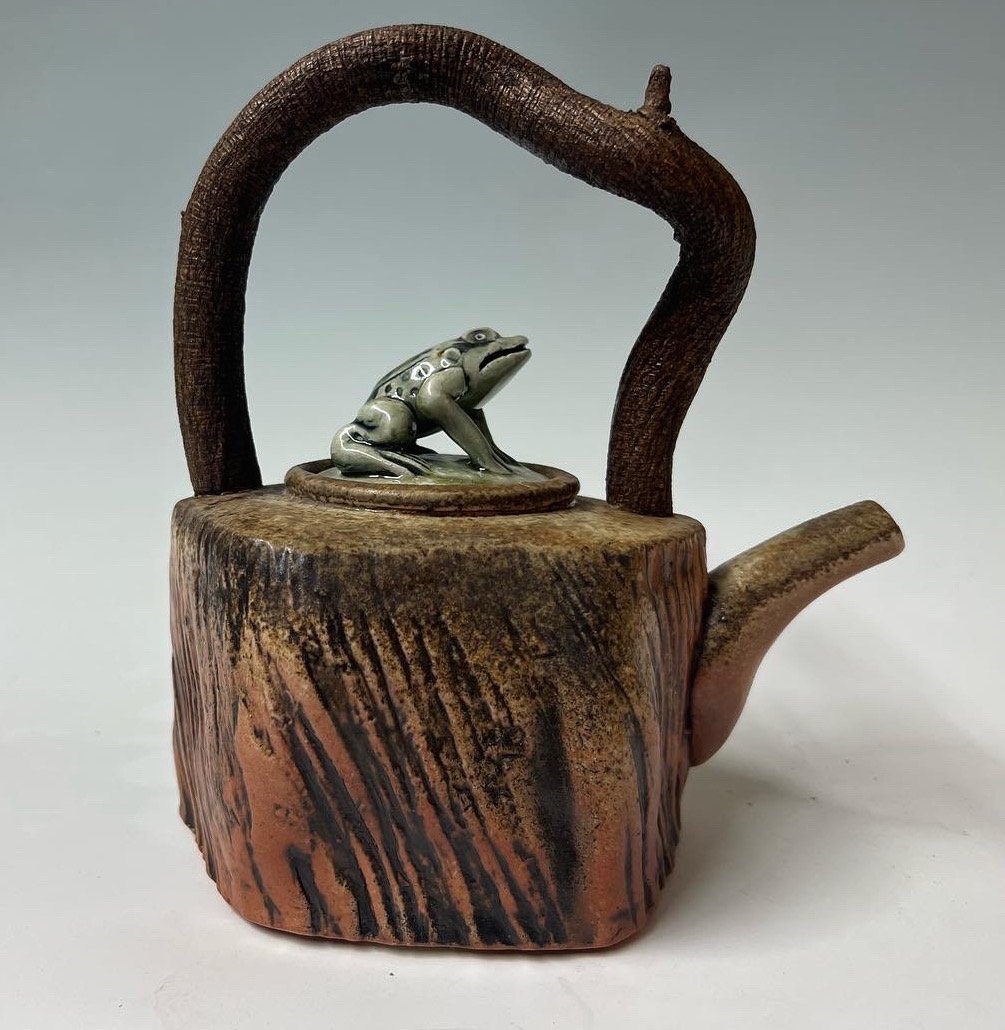Interview with artist Stephen Driver
Stephen Driver is a potter living and working near Oark, Arkansas. His wood fired earthenware and porcelain pottery celebrate the natural beauty of the region. More of Stephen’s work can be seen at Boswell Mourot Fine Art in Little Rock and at Little Mulberry Gallery in Ozark. (profile photo by Alive Driver, ceramics photos by George Chambers)
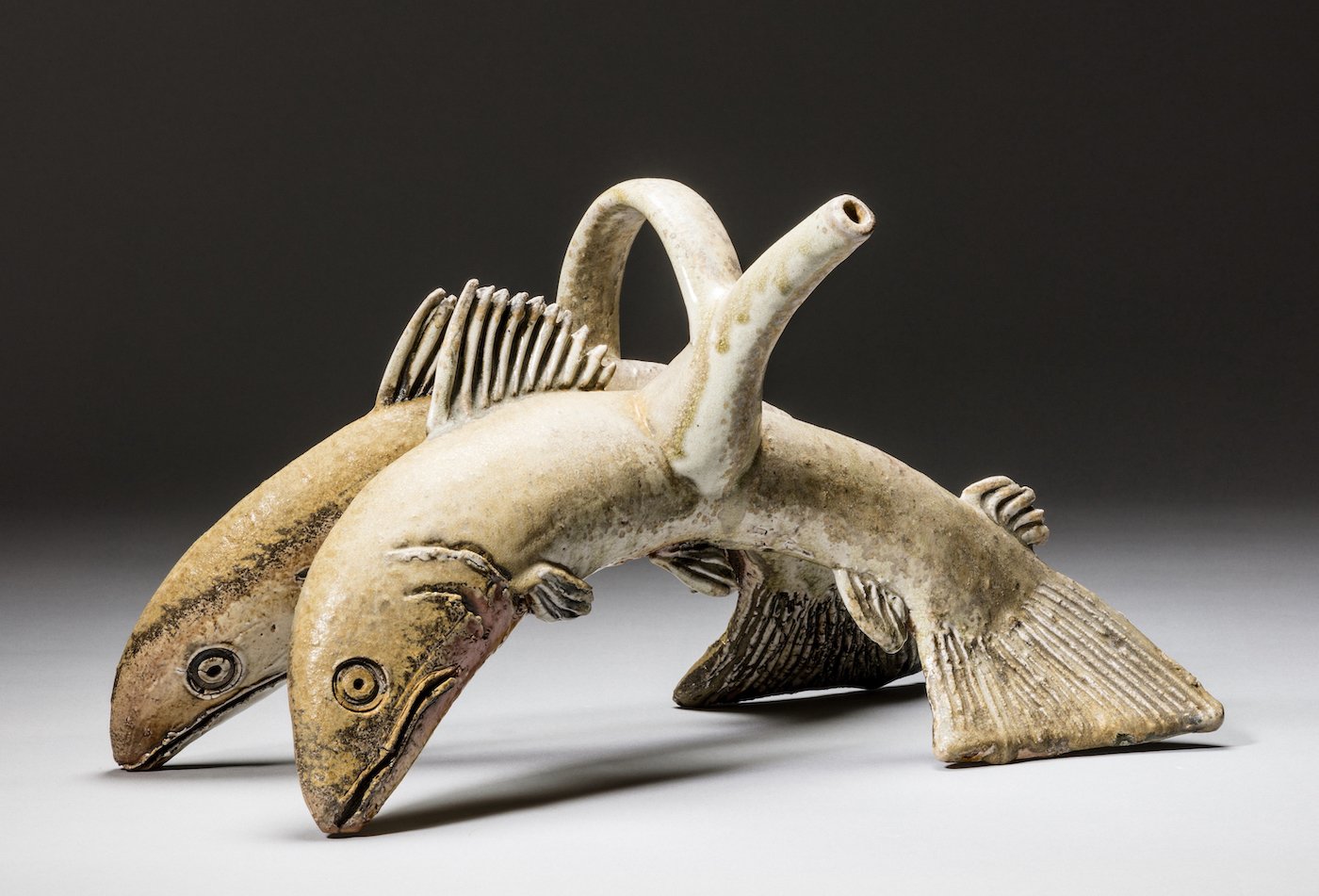
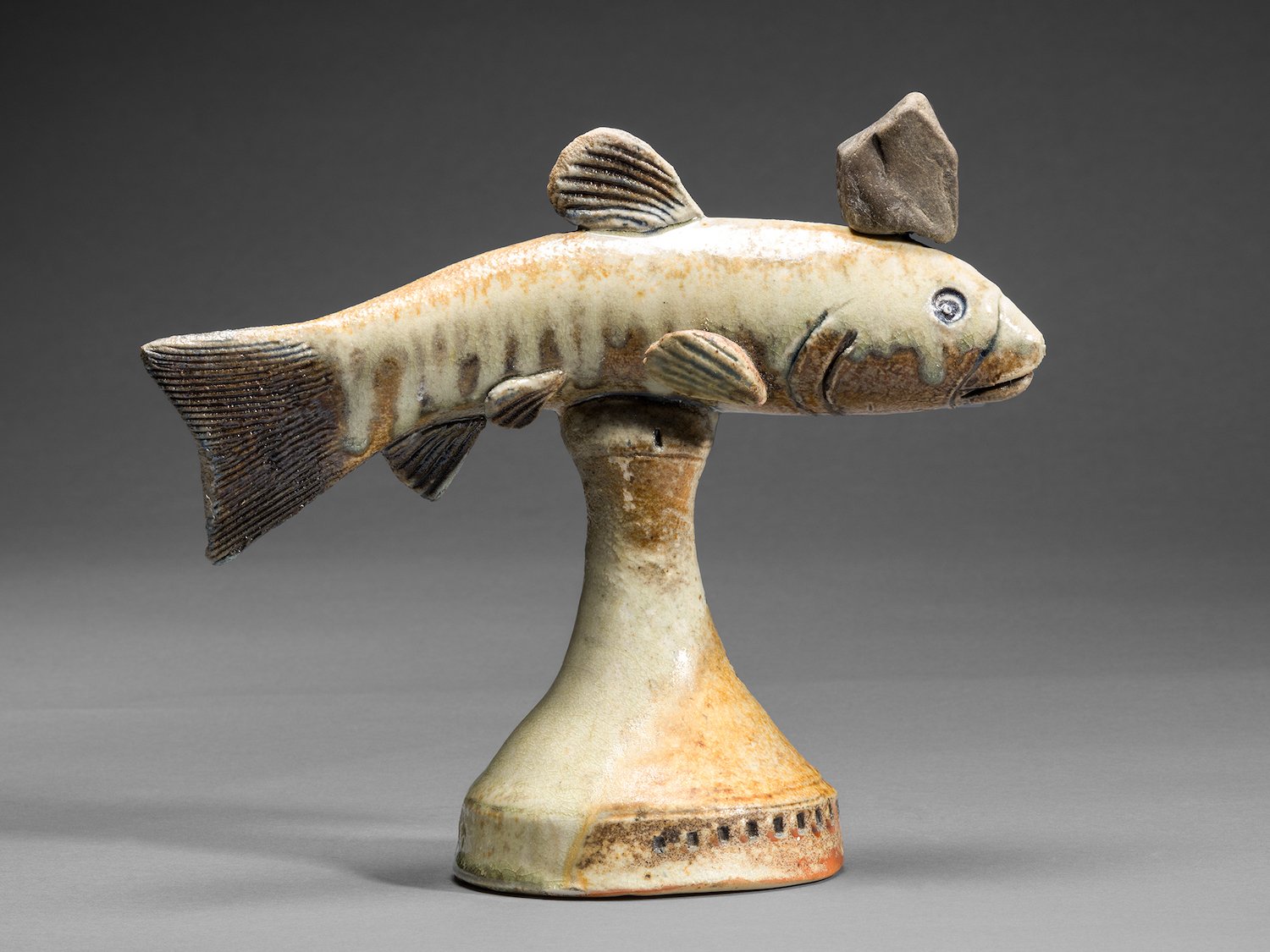
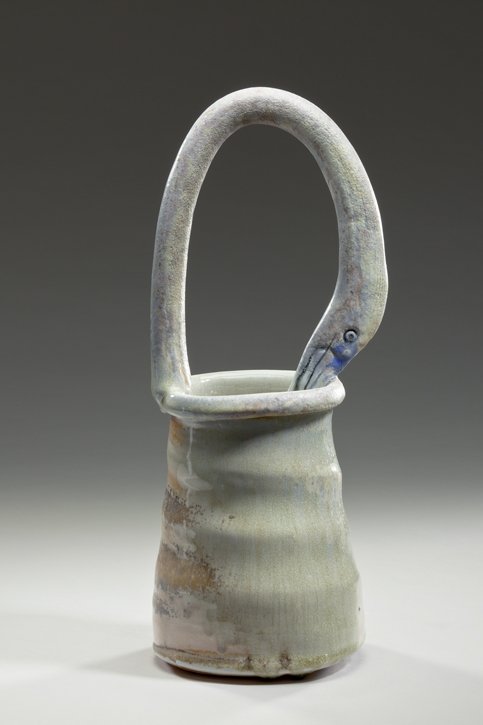
AAS: Stephen, you have lived in the Oark/Ozark area for many years, but where are you originally from and what brought you to Arkansas?
SD: I was born in Seattle, Washington and my family moved to Detroit when I was five years old. I had a former professor from Florida State University who gave up tenure and moved to the Ozarks to carve wood. Out of curiosity I made my first trip to Arkansas for a visit. His name is Bob French and he helped me and three of my brothers find the piece of land that we bought in the fall of 1975. We were ‘back to the landers’ and I just wanted to make pots, fire my kilns with wood and grow my own food. Two of my other brothers were also artists and my twin brother, Larry, was an elementary school teacher. The land was beautiful, bordered on two sides by the Ozark National Forest, had a swimmable creek along one border and was fairly inexpensive back then. We moved on the land in the spring of 1976 and we all started building our own houses. It took me about three years to get my house finished enough to move into, build a kiln and set up my studio on the first floor.
AAS: Tell me more about your education and studio experiences.
SD: I became interested in clay in high school. I was not a particularly engaged student academically. But was a pretty good athlete. Art and the swimming kept me focused enough to graduate. My father died when I was 14 and in hindsight I was adrift emotionally through high school and my first couple years of college. I went to FSU on a swimming scholarship, and I talked my way into getting to take ceramics classes even though I was not an art major. During the summer of 1971, I signed up for a workshop in Grass Valley, California to build a six chambered wood fired kiln. That workshop changed my life and I returned the next summer. By the spring of my senior year I had decided that I wanted to become a potter.
Quite magically in the spring of 1973, my aunt Alice asked me If I wanted to live with her and make pots for the summer with a couple who owned a pottery in a old grist mill in the mountains of Northeast Georgia. I ended up working for them two years and John and Glen LaRowe became my “pottery parents” and we had life long working relationship/friendship. They encouraged me to develop my skills and to study at Penland School of Craft. They also helped me with my plane fare to England when in 1975 I secured an apprenticeship with the British potter, Michael Leach – son of the famous potter Bernard Leach. Working for Michael turned out to be difficult and I quit after three months. Quite fortunately, I was able to secure work with Peter Bruce Dick, a wood fired earthenware potter who had apprenticed for Michael Cardew and Ray Finch. Peter was a marvelous mentor and we maintained a lifelong friendship. When I had my one and only sabbatical, I went back to York and worked with Peter for a couple of months. After working in England, I, quite naively, thought I knew enough to start my own pottery and moved to the Ozarks.
After 12 years of making pots for a living I hit a wall in terms of my work. I was doing production work, craft shows and wholesaling a lot to craft galleries all over the south. I was working very long hours , burning out and felt that my work was not very good. Realized that I had learned how to make pots but had not taken the time to find out what I wanted to say with my work. In 1984, after a disastrous attempt at a partnership with a British potter, I applied to graduate school at the University of Georgia to work with Ron Meyers. Started grad school in the spring of 1986 and it was one one the best things I had ever done for myself.
AAS: Tell me about your studio at Mulberry Creek Pottery.
Wood fired kilns at Mulberry Creek Pottery.
SD: When I first moved to the Ozarks in 1976, I had not met my wife [Louise Halsey] but had started building my house with a studio downstairs and living quarters upstairs without thinking about having a partner. After a couple of years my pottery business began to grow and in 1981, we had our daughter Alice. I traded some pasture with my brothers for their share in a 40’ x 24’ tractor shed on the property and moved my studio there, Louise took over my old space and Alice took over hers. Over the years I have expanded that shed space and have built three wood fired kilns.
AAS: You’ve taught at universities across the south including at UALR. What do you enjoy about teaching and what kinds of instruction do you offer at Mulberry Creek Pottery?
SD: Actually, I have only had two full time tenure track teaching jobs; 14 years at Brescia University in Owensboro, Kentucky and 5 years at UALR. I did teach for a semester at the University of Mississippi as a sabbatical replacement and was an artist in residence at Southern Arkansas University. I also taught in the Artist in Education Program with the Arkansas Arts Council after grad school and before teaching full time.
I really love sharing my knowledge and skills with people who want to learn about ceramics, techniques, creative process, firing, and art history. After twenty years of making a living as a potter and going back school get my MFA, I thought I had something to say, something to pass on. In the past year I have done a couple of workshops/consulting gigs – one at Louisiana Tech University this spring and one at Hendrix College in August and I am teaching a 5 day workshop, if enough people sign up, in San Miguel de Allende, Mexico this coming January.
I have plans to have workshops up here at my studio, but I have not done so yet for a variety of reasons that I won’t bore everyone with. Right now, just pulling off the loading and firing with fifteen people helping me fire my big wood kiln is all that I can handle. I guess you could say that firing my big two-chambered kiln is a form of instruction.
“What I really love about clay besides just the love of the material itself is the possibility of invention in the process of just working every day in the studio. That kind of path to new work only happens while working and being deeply involved in the process. When that moment happens, it is blissful and the happiest moment ever!”
AAS: You make functional pottery as well as more sculptural pieces – but many merge the two. One of my favorites is Green Teapot with Frog Lid. Tell me about that piece.
Green Teapot with Frog Lid and Wisteria Handle, 8"H x 8"W x 5"D, wood fired porcelain
SD: I have always been into making pots that were well designed, highly functional, and durable. I started making sculptural work in graduate school. I became very interested in the figure and made a series of what I call goddess figures for at least a decade. In the early 2000’s I started making effigy vessels starring herons and woodpeckers-my favorites. Over the years I have added more animals to my menagerie and it is just in the last five years that I have incorporated animals into my functional pots. In 2017 I was an Artist in Residence at Lanzhou City University in western China and it was there, looking at and studying the rich history of Chinese ceramics that I saw a way to integrate animals in my pots. So far, frogs as knobs are only on the lids of jars and teapots.
The green frog on the lid of the teapot is new. As I was preparing for my show at Boswell Mourot Fine Art this summer, I was casting about for something new to do rather than just using the ash landing on the pots from the wood firing for surface effects.
AAS: I am guessing you get a lot of inspiration from the wildlife around the Mulberry River and the Ozark National Forest. I am a big fan of frogs and love Fish and Double Frogs. Is it glazed or is that coloration a natural result of the firing?
Fish and Double Frogs, 7"H x 16"L x 5"D wood fired stoneware
SD: Yes, I do get a lot of inspiration from the animals in my hood. We have a lot of toads and other amphibians that hang out in my woodpiles around my studio, pond, creek and in our gardens. I am also influenced by the work of my mentor and friend Ron Meyers. Over the last twenty years I have spent a week or two at Ron’s Studio in Athens, Georgia helping him fire his wood kiln. I also have quite of few of his pots in my house. Over time they have inspired me explore and develop my own menagerie and my own ways of integrating them into my work.
Yes, the color and surface effects on many of my pots and sculptures are just the result of firing with wood. For the Fish and Double Frogs piece, I did spray a flashing slip on it that encourages the orange color and the rest of the surface effects are from ash melting on it. I have stated in the past that I prefer painting with the fire over decorating my work.
AAS: I have to ask about Climate Change Waiter Fish #4 with Fortune Cookie. It is a very fun piece but with a strong message. What are you saying with that piece?
Climate Change Waiter Fish #4 Fortune Cookie, 27"H x 8"W x 6"D, stoneware, melamine plate, and fortune cookies
SD: I have been making pieces about climate change for quite some time now. I like using humor to get across what I want to say and did a series of these waiter fish, imagining them sort of like the Marx Brothers coming out of the kitchen and awkwardly delivering the bad news about the climate. I curated an exhibition of Arkansas wood fired potters at the Butler Center in 2016 and all of my waiter fish debuted there. The fortune cookies were especially made with quotes about climate change in them and I encouraged people to take a fortune cookie off the plate, open the cookie, and read it. I spent at least $200 on fortune cookies for that exhibit alone. It is one my better Ideas and I thought it was wonderful how it turned out, but I don’t think people really got it. But it was fun to see people’s faces when they opened up the cookie and it said, “We’re Fucked”, an actual quote from a climate scientist, or the listing the number of species that went extinct today.
AAS: I want to get back to your more functional stoneware. I think there is something especially comforting about preparing and serving a meal with handmade stoneware and porcelain. You make some wonderful baking dishes and bowls that are very organic and convey the movement of flowing water. What do you hear from people who purchase pieces like those?
Unfolding Bowl, 17"W x 7"H, salt/soda wood fired porcelain
Baking Dish, 3"H x 14"L x 6"D, salt/soda wood fired stoneware
SD: I have always seen good functional pottery as art. Art that is tactile and visually intriguing that can transform the eating and drinking experience. I call it the secret life of objects. Good pots add to the atmosphere and the quality of the conversation. Presentation of food on good handmade pottery always improves the eating experience.
I see making pots as a form of seduction. A successful pot should compel the user to want to pick it up, hold it in their hands, and unconsciously explore the vessel, tactilely as well as visually. When I see someone using a mug or cup in this way, I know I have succeeded in making a good pot.
Thanks you for noticing the flowing organic asymmetrical aspects of some of my pots. When I am throwing a piece on the wheel there is something quite pleasing about the plastic fluid look of the pot at that stage and it often diminishes as the pot dries and is fired. I have for years sought to manipulate the clay in such a manner as to capture that fluid organic quality in the finished vitrified piece. When it works it is quite thrilling. I have even come up with a term for it, Ozark Wabi. I even own the domain name ozarkwabi.com, in English and Japanese!
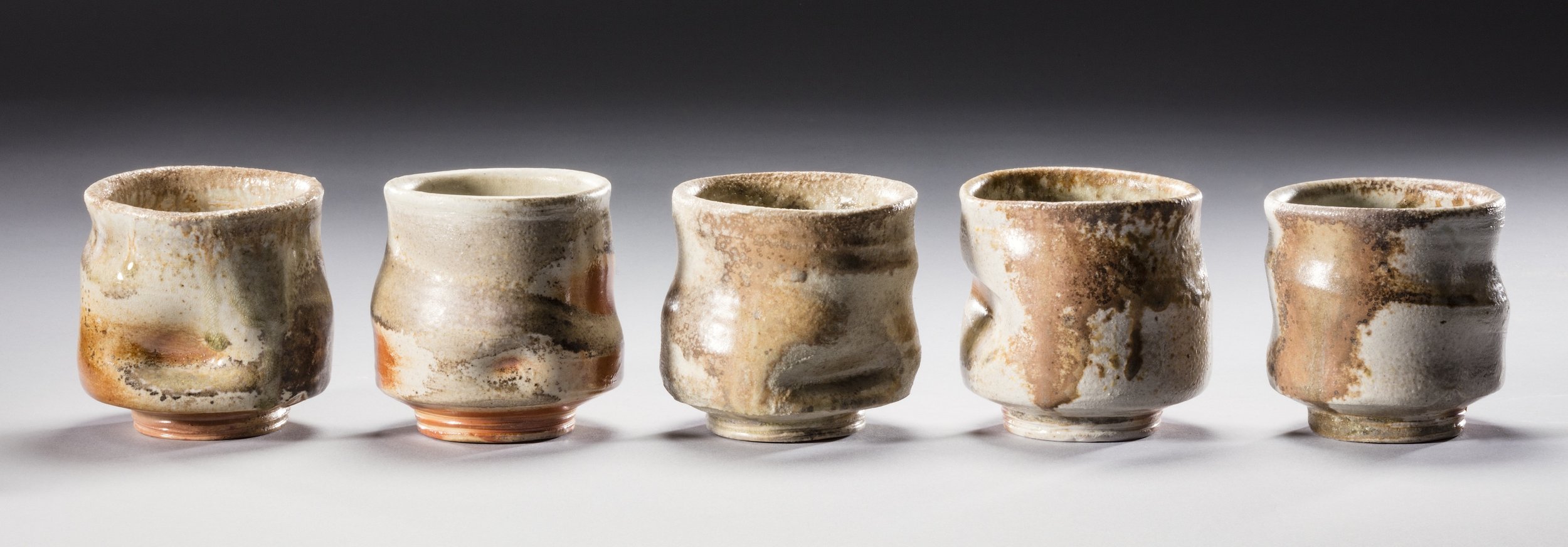

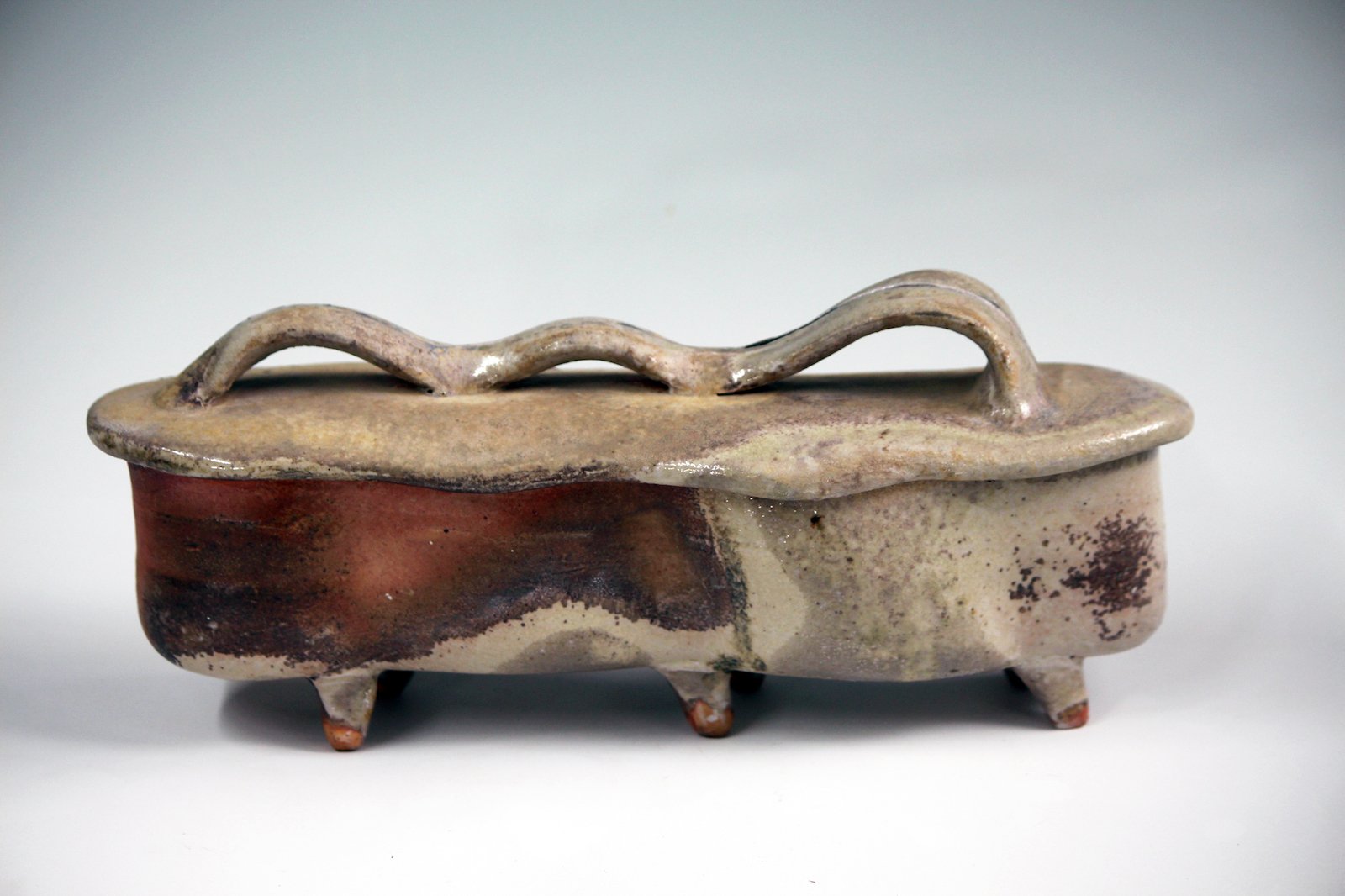
AAS: Ozark Wabi – love it! I guess potters especially need to embrace wabi-sabi. Tell me, what satisfaction or comfort to you get from working with clay and then the ultimate excitement of opening the kiln to see what really happened.
SD: I have loved working in clay from the first time I touched it in 11th grade. There never was any intellectual aspect to it; I was pulled in like a tractor beam in a Syfy film. When I was a freshman at Florida State I was walking back to my dorm and unconsciously wondered up to the ceramics studio and entered without thinking. Turns out the professor, who I met at the door questioning my presence, was a graduate of Cranbrook, which happened to not be too far from where I grew up in Detroit. Our art classes visited Cranbrook on field trips from high school. I guess he could see that I had already drunk the clay Kool-Aid and he let me take a ceramics class contrary to the rules. Passion does open doors at times.
What I really love about clay besides just the love of the material itself is the possibility of invention in the process of just working everyday in the studio. That kind of path to new work only happens while working and being deeply involved in the process. When that moment happens, it is blissful and the happiest moment ever!
Opening a kiln and seeing pots that exceed expectations, holding those warm vessels in your hands is also quite a thrill. But in every firing there are those highs but also disappointments with work that does not sing or is damaged and cracked. I can get quite grouchy while unloading a kiln. This is true, especially with wood firing because so much can happen and go right or wrong. Very different from electric firing where what you see is what you get. Sometimes a pot does not reveal its full potential until it sits around for awhile and grows on you – changes you. Wood firing is very much where you want to be to explore the wabi-sabi aesthetic.
AAS: I also want to ask about Ecuador Ghost Vessel #2 and your Tomb Ware series. They are so esthetically pleasing and comforting in a way. Are they crafted and fired in traditional techniques?
Ecuador Ghost Vessel #2, 11"H x 10"W x 7"D, wood fired porcelain
SD: In 2006 I got a chance to go Ecuador with a friend of mine who was doing research on the indigenous women potters of the upper Amazon. We both loved to go look at collections of pre-Columbian pottery when we were not in the jungle. I found the Ecuadorian pre-Columbian pots to be remarkable and amazingly good, even better than pre-Columbian Peruvian pots. I did a lot of sketching and when I came home I had about a month in my studio before I went back to teaching. It was a great gift of time to explore those forms. Traditionally those Ecuadorian pots were made of earthenware clay and fired at a low temperature and the scale of those pots were not very big. I decided to work on a larger scale and also to use porcelain. I only made six or so pots that I thought were good enough to keep and fire. Several months later I fired them in Ron Meyers wood fired kiln at Athens, Georgia. The lovely subtle lavender surface came from a process called reduction cooling. All six of those pots came out as amazing beautiful as this one. Unfortunately, I was only able to get that kind of color for a couple of firings and then it didn’t work that way anymore and have not revisited those forms again.
AAS: Can you talk about the people who have influenced and helped you along the way during your 50-year long life in clay?
SD: A list of all the people who have encouraged me, saw value in what I was trying do and helped me along this path of mine is incredibly long. My family is certainly at the top. My mother, my wife Louise, my children, my four brothers and all my sister in laws and ex sisters in law, my aunt Alice, cousins, nieces and nephews. The list of teachers and mentors and other potters who contributed is also long. The list of those who went deep into in the pottery woods with me and shared the love of a beautiful pot and working with one’s hands is short.
They are Peter Bruce Dick, Coxwold, York, England, who taught me how to make pots properly. Ron Meyers who was helpful, kind and encouraged me from the first time I met him in 1973. He also continues to remind me to loosen up. Richard Hotchkiss and Rimas VisGirda who started the Earth Air Fire Water Workshops in Grass Valley, California where I fell in love with wood firing and decided that I wanted to be a potter. Michael Simon, who let me hangout, talk about pots and life while unloading kilns or in his driveway hitting golf balls. Kevin Crowe, a Virginia potter, who always saw value in my work and in me and convinced me to build my big wood kiln. Joe Molinaro, the potter who invited me along for adventures with clay in Ecuador and getting to know those amazing women potters of the Amazon who changed me and changed my work.
